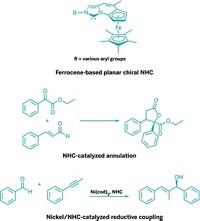Advertisement
Grab your lab coat. Let's get started
Welcome!
Welcome!
Create an account below to get 6 C&EN articles per month, receive newsletters and more - all free.
It seems this is your first time logging in online. Please enter the following information to continue.
As an ACS member you automatically get access to this site. All we need is few more details to create your reading experience.
Not you? Sign in with a different account.
Not you? Sign in with a different account.
ERROR 1
ERROR 1
ERROR 2
ERROR 2
ERROR 2
ERROR 2
ERROR 2
Password and Confirm password must match.
If you have an ACS member number, please enter it here so we can link this account to your membership. (optional)
ERROR 2
ACS values your privacy. By submitting your information, you are gaining access to C&EN and subscribing to our weekly newsletter. We use the information you provide to make your reading experience better, and we will never sell your data to third party members.
Synthesis
Organocatalyst Passes Chirality Along
Supramolecular catalyst could point the way to a powerful new strategy for finding novel organocatalysts
by Amanda T. Yarnell
August 31, 2009
| A version of this story appeared in
Volume 87, Issue 35
3H2cxd_opt?$responsive$&wid=150&qlt=90,0&resMode=sharp2)
An asymmetric catalyst that assembles spontaneously from simple organic components could point the way to a powerful new strategy for finding novel organocatalysts, according to researchers in Japan. Takashi Ooi, Daisuke Uraguchi, and Yusuke Ueki of Nagoya University built the catalyst simply by mixing a chiral tetraaminophosphonium cation, two phenols, and a phenoxide anion in solution (Science, DOI: 10.1126/science.1176758). The catalyst is held together by relatively weak hydrogen-bonding and ionic interactions. It’s remarkable that stereochemical information in the chiral phosphonium cation is effectively relayed by achiral phenols all the way to the remotely located phenoxide anion, comments Sukwon Hong of the University of Florida, Gainesville. The extended chiral environment that results allows the catalyst to promote the highly stereoselective conjugate addition of acyl anion equivalents, Ooi’s team finds. The catalyst’s discovery “points the way to a combinatorial strategy for finding new supramolecular organocatalysts,” says Joost N. H. Reek of the University of Amsterdam. Such a strategy is already being explored to make supramolecular transition-metal catalysts, he notes.





Join the conversation
Contact the reporter
Submit a Letter to the Editor for publication
Engage with us on Twitter